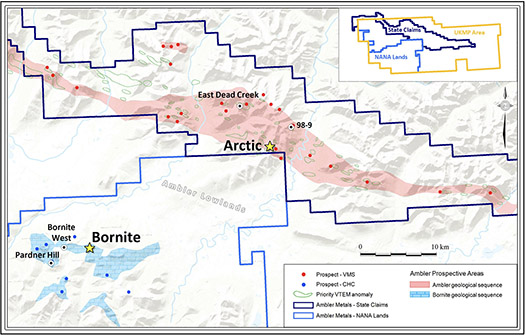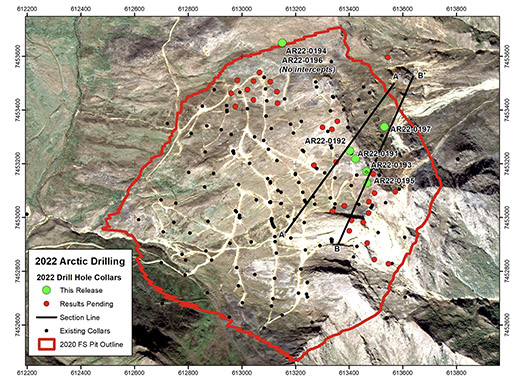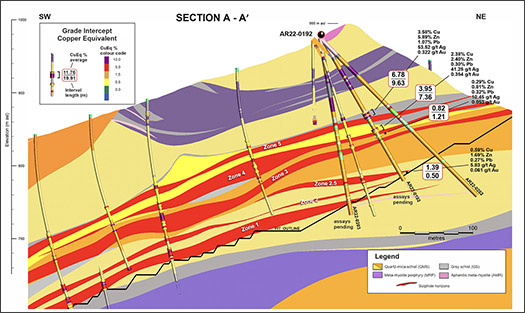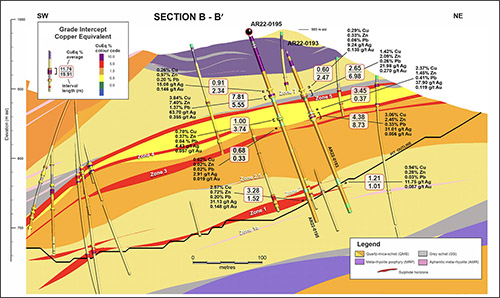Trilogy Metals Announces First Results of the 2022 Arctic Drill Program at the Upper Kobuk Mineral Projects
November 29, 2022
Multiple Intercepts of High-Grade Copper, Zinc and Silver Mineralization, including 9.63 Meters with a Copper Equivalent Grade of 6.78% and 5.55 Meters with a Copper Equivalent Grade of 7.81%
November 29, 2022 – Vancouver, British Columbia – Trilogy Metals Inc. (TSX/NYSE American: TMQ) ("Trilogy" or the "Company") is pleased to announce the first set of drilling results from the 2022 summer field season at the Upper Kobuk Mineral Projects ("UKMP") located in northwestern Alaska. The UKMP includes the Arctic (volcanogenic massive sulphide, or "VMS") deposit ("Arctic"), the Bornite (carbonate-hosted copper, or "CHC") deposit ("Bornite"), and prospective mining claims in the surrounding area. The drill program was completed by Ambler Metals LLC ("Ambler Metals"), the joint venture operating company equally owned by Trilogy and South32 Limited (ASX, LSE, JSE: S32; ADR: SOUHY) ("South32").
The 2022 field program included 10,738 meters of diamond drilling, of which 8,376 meters was drilled at Arctic, the most ever drilled at Arctic in a single field season, while the remainder of the meterage was used on regional targets in the Ambler VMS Belt and near Bornite. The 2022 field program prioritized advancing Arctic with additional infill drilling to further improve the confidence in the resource and for geotechnical studies to further de-risk the project.
Drilling Highlights
Drill holes AR22-0192 and AR22-0195 were drilled as part of the 2022 Arctic infill program designed to increase confidence from Indicated to Measured in areas of the mineral resource block model that would be mined during the first four years of production, based on Trilogy's 2020 Arctic feasibility study† mine plan and with the highest estimated metal value.
Significant zones of high-grade copper, zinc, lead, gold, and silver mineralization were intersected, including:
- AR22-0192 intersected four mineralized intervals, including 9.63 meters of 3.58% copper, 5.89% zinc, 1.07% lead, 0.32 grams per tonne (g/t) gold and 53.52 g/t silver for a copper equivalent grade of 6.78%.
- AR22-0195 intersected five mineralized intervals, including of 5.55 meters of 3.84% copper, 7.40% zinc, 1.37% lead, 0.36 g/t gold and 63.70 g/t silver for a copper equivalent grade of 7.81%.
_____________
† National Instrument 43-101 technical report titled "Arctic Feasibility Study Alaska, USA NI 43-101 Technical Report" with an effective date of August 20, 2020 and a release date of October 2, 2020 (the "2020 Feasibility Study")
Tony Giardini, President and CEO of Trilogy, commented, "We are pleased to collaborate with Ambler Metals, South32 and NANA on the largest exploration program in the history of the Arctic deposit, and to continue unlocking its world-class mining district potential as a critical source of green metals for the US economy, in line with President Biden's Inflation Reduction Act."
The drill results contained in this news release are from the first seven drill holes of the 2022 Arctic drill program, AR22-0191 through to AR22-0197, which include four infill holes and three geotechnical holes (AR22-0194, 0196 and 0197). All drill holes are sized HQ3 (63.5 mm diameter). Within the Arctic deposit, mineralization occurs as stratiform semi-massive sulphide to massive sulphide beds within primarily graphitic to chloritic schists and fine-grained quartz schists. Sulphide mineralogy is similar for all intercepts: chalcopyrite, sphalerite and galena. Results indicate mineralization is reasonably continuous, especially in Zone 5 which is typically the highest grade and thickest zone at Arctic.
The results of the remaining holes are expected to be announced in the coming months. For full details of the 2022 drill program, see Trilogy's news release dated June 8, 2022.
As part of the goal of de-risking Arctic, the geotechnical holes were planned to further define the talc horizons in the pit design as outlined in the 2020 Feasibility Study. The holes were drilled at or beyond the edges of the resource and as expected, drill holes AR22-0194 and 0196 did not intersect mineralization while hole AR22-0197 intersected a narrow zone of weak mineralization as shown in Table 1. Trilogy anticipates that the results may impact engineering of the Arctic open-pit design by pushing back the pit slope in the northeast corner which may increase the strip ratio, improve mine life and slightly reduce reserve grade. The Company intends to prepare a technical study on Arctic effective this fiscal year-end to comply with SEC mining disclosure regulations under SK-1300, and an updated National Instrument 43-101 feasibility study.
Exploration outside of the Arctic deposit focused on discovering copper-rich satellite deposits near Arctic, and in the Cosmos Hills (see Figure 1). As part of the regional program, two VMS targets in the Ambler Belt, 98-9 and East Dead Creek, and two CHC targets near Bornite were drill tested (assays pending). In addition, an area covering more than 50km2 was mapped and prospected, and over 3,900 soil samples were collected.
Richard Gosse, Vice President, Exploration at Trilogy, stated, "We are encouraged by the results of this first set of holes, received from a record total number of meters drilled at Arctic (8,376 meters) in one season, in addition to seven regional drill holes, and extensive geological mapping and soil sampling at several other VMS prospects in the belt, including Ambler, Dead Creek, Sunshine and COU. We look forward to announcing more results from this comprehensive program in the next few months, with a view of upgrading the Indicated Resources at Arctic to Measured."
Mineralized intervals of high-grade mineralization at a cut-off of 0.5% copper equivalent are reported in Table 1. The locations of the holes are shown in Figure 2 and Table 2.
Table 1. Drill Intercepts from the 2022 Arctic Infill Drilling Program
| Hole | From (m) |
To (m) |
Length (m) |
Au (g/t) |
Ag (g/t) |
Cu (%) |
Pb (%) |
Zn (%) |
CuEq (%) |
Ba (%) |
Zone |
|---|---|---|---|---|---|---|---|---|---|---|---|
| AR22-0191 including |
103.26 | 104.48 | 1.22 | 0.298 | 23.65 | 0.24 | 0.22 | 0.45 | 0.87 | 2.37 | 7 |
| 108.81 | 114.60 | 5.79 | 0.499 | 41.63 | 2.45 | 0.80 | 3.23 | 4.60 | 2.35 | 5 | |
| 133.20 | 133.50 | 0.30 | 0.049 | 11.80 | 1.38 | 0.25 | 2.83 | 2.64 | 0.01 | 4 | |
| 138.78 | 145.90 | 7.12 | 0.039 | 6.17 | 2.12 | 0.02 | 1.83 | 2.88 | 0.02 | 3 | |
| 231.42 | 232.23 | 0.81 | 0.016 | 1.09 | 0.56 | 0.00 | 0.03 | 0.59 | 0.21 | 1 | |
| AR22-0192 including |
118.52 | 128.15 | 9.63 | 0.322 | 53.52 | 3.58 | 1.07 | 5.89 | 6.78 | 6.88 | 5 |
| 145.25 | 152.61 | 7.36 | 0.354 | 41.25 | 2.38 | 0.30 | 2.40 | 3.95 | 1.43 | 4 | |
| 157.17 | 158.38 | 1.21 | 0.053 | 10.45 | 0.29 | 0.32 | 0.81 | 0.82 | 0.06 | 3 | |
| 219.60 | 220.10 | 0.50 | 0.061 | 5.83 | 0.59 | 0.27 | 1.69 | 1.39 | 0.01 | 2 | |
| AR22-0193 including |
90.53 | 93.00 | 2.47 | 0.138 | 9.24 | 0.29 | 0.06 | 0.33 | 0.60 | 3.43 | 7 |
| 96.51 | 103.49 | 6.98 | 0.270 | 21.98 | 1.42 | 0.26 | 2.09 | 2.65 | 3.30 | 5 | |
| 126.13 | 126.50 | 0.37 | 0.119 | 37.90 | 2.37 | 0.41 | 1.45 | 3.45 | 0.01 | 4 | |
| 130.01 | 138.74 | 8.73 | 0.056 | 31.01 | 3.06 | 0.33 | 2.45 | 4.38 | 0.06 | 3 | |
| 239.88 | 240.89 | 1.01 | 0.087 | 11.75 | 0.94 | 0.03 | 0.28 | 1.21 | 0.21 | 1 | |
| AR22-0195 including |
85.05 | 87.39 | 2.34 | 0.146 | 15.08 | 0.26 | 0.20 | 0.97 | 0.91 | 4.17 | 7 |
| 92.98 | 98.53 | 5.55 | 0.355 | 63.70 | 3.84 | 1.37 | 7.40 | 7.81 | 3.48 | 5 | |
| 128.30 | 132.04 | 3.74 | 0.057 | 4.43 | 0.78 | 0.04 | 0.37 | 1.00 | 0.05 | 3 | |
| 143.15 | 143.48 | 0.33 | 0.019 | 2.91 | 0.62 | 0.02 | 0.02 | 0.68 | 0.01 | ? | |
| 253.38 | 254.90 | 1.52 | 0.148 | 31.13 | 2.57 | 0.20 | 0.72 | 3.28 | 0.39 | 1 | |
| AR22-0197 | 6.29 | 6.61 | 0.32 | 0.003 | 1.10 | 0.54 | 0.02 | 0.20 | 0.63 | 0.11 | 5 |
Notes:
- Copper equivalent (CuEq) calculations use metal prices assumptions of $3.00/lb for copper, $1.10/lb for zinc, $1.00/lb for lead, $1,300/oz for gold, and $18.00/oz for silver.
- Results are core intervals and not true thickness; true widths have not been determined for the above intercepts but are believed to be within 80% of actual drill thicknesses.
- Cut-off grade of 0.5% CuEq.
- Internal dilution up to three meters of <0.5% CuEq.
- Core recovery averaged 94%.
- Within mineralized zones the minimum sample length was 0.14m, maximum sample length was 2.81m, and the average sample length was 1.49m.
- Some rounding errors may occur.
Figure 1. UKMP Prospective Areas and Key Prospects
Figure 2. Location of Arctic Drill Holes from the UKMP Drilling Program
Drill holes AR22-0191, 0192, 0193 and 0195 which are sized HQ3 (63.5 mm diameter), were drilled as part of the 2022 Arctic infill program to increase confidence from Indicated to Measured in areas of the mineral resource block model that would be mined during the first four years of production, based on Trilogy's 2020 Feasibility Study mine plan and with the highest estimated value (see Figure 2). The holes, as seen in Figures 3 and 4, indicate mineralization is reasonably continuous, especially in Zone 5 which is typically the highest grade and thickest zone at Arctic. Sulphide mineralogy is similar for all intercepts: chalcopyrite, sphalerite and galena.
Figure 3. Cross Section Showing Hole AR22-0192
Figure 4. Cross Section Showing Holes AR22-0193 and 0195
Table 2. Drill Hole Locations at the Arctic Project
| Hole | Easting | Northing | Elevation | Azimuth | Dip | Length |
|---|---|---|---|---|---|---|
| AR22-0191 | 613427.48 | 7453222.71 | 977.33 | 54 | -63 | 285.6 |
| AR22-0192 | 613408.01 | 7453239.69 | 974.71 | 41 | -58 | 270.36 |
| AR22-0193 | 613465.12 | 7453172.51 | 983.18 | 41 | -68 | 282.55 |
| AR22-0194 | 613144.13 | 7453644.46 | 895.11 | 35 | -65 | 24.84 |
| AR22-0195 | 613468.42 | 7453130.31 | 980.45 | 35 | -70 | 295.66 |
| AR22-0196 | 613145.12 | 7453645.07 | 895.29 | 90 | -70 | 91.44 |
| AR22-0197 | 613534.13 | 7453336.95 | 905.04 | 35 | -70 | 12.95 |
Coordinates are in UTM Zone 4N (meters) coordinate system, NAD83 Datum.
QA/QC Program
The drilling program, sampling and assaying protocol, and data verification were managed by qualified persons (QPs) employed by Ambler Metals. The diamond drill holes were completed using HQ3 diameter core, and recoveries averaged 94%. Drill core was cut lengthwise into halves using a diamond saw, and one-half was cut lengthwise to provide quarter core for sampling. The remainder of the core was retained in core boxes and archived at site.
Samples were collected through mineralized zones using a 0.14 m minimum length and 2.81 m maximum length; average sample length is 1.49 m. Weights of the drill core samples range from 0.81 to 11.94 kg, depending on the size of core, rock type, and recovery.
Each core sample was placed into a bag with a numbered tag and quality control samples were inserted between core samples using the same numbering sequence. Then, samples were grouped into batches for shipping and laboratory submissions. Each batch of 20 samples contains quality control (QC) samples that comprise one certified reference material (CRM), one core blank (BLK), and one crushed or pulp duplicate (DUP). In addition, 1 core duplicate was taken within mineralized intervals for every 20 samples. Chain of custody records are maintained for sample shipments and the custody is transferred from Ambler Metals expeditor to the laboratory upon delivery.
Samples were shipped to ALS Minerals laboratory in Fairbanks, Alaska, USA, for sample submission. ALS Minerals Fairbanks is a satellite sample preparation facility accredited under ALS Minerals. The ALS Minerals Fairbanks shipped the samples to ALS Minerals in North Vancouver, B.C., Canada, for sample preparation and analysis. ALS Minerals North Vancouver is an independent laboratory certified under ISO 9001:2008 and accredited under ISO/IEC 17025:2005 by the Standards Council of Canada. Selected sample batches were sent to ALS Minerals laboratory in Vientiane, Laos for fire assay. ALS Minerals includes its own internal quality control samples comprising certified reference materials, blanks, and pulp duplicates.
Drill core samples were weighed (WEI-21), dried if excessively wet (DRY-21), coarse jaw crushed to 70% passing 6 mm (CRU-21), fine jaw crushed to 70% passing 2 mm (CRU-31), riffle split to 250 g subsamples (SPL-21) and pulverized to 85% passing 75 μm (PUL-31). Crushed duplicates were created by riffle splitting crushed samples into two parts.
Gold analyses were completed using a 30 g lead fire assay and AAS finish (Au-AA23). Multi-element analyses for 48 elements were completed using a geochemical four acid digestion and ICP-ES/MS finish (ME-MS61). Over-range assays for Ag, Cu, Zn, and S were completed using an ore grade four-acid digestion and ICP-ES finish (ME-OG62). Additional analyses were completed for Ba and Hg.
Au, Ag, Cu, Pb, and Zn assays for QC samples were reviewed to ensure that CRMs are within tolerance limits specified on supplier certificates, BLKs are below acceptable thresholds, and DUPs display statistical patterns normally expected for sample types, methods, and elements. CRMs that returned assays outside of tolerance limits and BLKs with assays above thresholds were deemed to have failed. Sample batches containing failed QC samples were re-assayed to ensure that the QC samples returned acceptable results before release. All QC monitoring data are reviewed and signed off by an independent QA/QC geologist.
There is no known relationship between core sample recoveries and assay grades. Ambler Metals will submit 5% of the assay intervals from prospective lithologies to a laboratory independent of ALS Minerals for check assaying.
Qualified Persons
Richard Gosse, P.Geo., Vice President, Exploration for Trilogy, is a Qualified Person as defined by National Instrument 43-101. Mr. Gosse has reviewed the scientific and technical information in this news release and approves the disclosure contained herein.
About Trilogy Metals
Trilogy Metals Inc. is a metal exploration and development company that holds a 50 percent interest in Ambler Metals LLC which has a 100 percent interest in the Upper Kobuk Mineral Projects in Northwestern Alaska. On December 19, 2019, South32, a globally diversified mining and metals company, exercised its option to form a 50/50 joint venture with Trilogy. The UKMP is located within the Ambler Mining District, one of the richest and most-prospective known copper-dominant districts in the world. It hosts world-class polymetallic volcanogenic massive sulphide deposits that contain copper, zinc, lead, gold and silver, and carbonate replacement deposits that have been found to host high-grade copper and cobalt mineralization. Exploration efforts have been focused on two deposits in the Ambler Mining District – the Arctic VMS deposit and the Bornite carbonate replacement deposit. Both deposits are located within a land package that spans approximately 181,387 hectares. Ambler Metals has an agreement with NANA Regional Corporation, Inc., an Alaska Native Corporation that provides a framework for the exploration and potential development of the Ambler Mining District in cooperation with local communities. Trilogy's vision is to develop the Ambler Mining District into a premier North American copper producer while protecting and respecting subsistence livelihoods.
Company Contacts
| Tony Giardini President & Chief Executive Officer |
Elaine Sanders Vice President & Chief Financial Officer |
604-638-8088 or 1-855-638-8088
# # #
Cautionary Note Regarding Forward-Looking Statements
This press release includes certain "forward-looking information" and "forward-looking statements" (collectively "forward-looking statements") within the meaning of applicable Canadian and United States securities legislation including the United States Private Securities Litigation Reform Act of 1995. All statements, other than statements of historical fact, included herein, including, without limitation, statements relating to interpretation of drill results; the Company's beliefs regarding the potential of the Upper Kobuk Mineral Projects; the Company's expectation that the drill program may impact engineering of the Arctic open-pit design; the anticipated timing of an updated feasibility study on Arctic; and the Company's expectations regarding de-risking of the Upper Kobuk Mineral Projects are forward-looking statements. Forward-looking statements are frequently, but not always, identified by words such as "expects", "anticipates", "believes", "intends", "estimates", "potential", "possible", and similar expressions, or statements that events, conditions, or results "will", "may", "could", or "should" occur or be achieved. Forward-looking statements involve various risks and uncertainties. There can be no assurance that such statements will prove to be accurate, and actual results and future events could differ materially from those anticipated in such statements. Important factors that could cause actual results to differ materially from the Company's expectations include the uncertainties involving success of exploration, permitting timelines, requirements for additional capital, government regulation of mining operations, environmental risks, unanticipated reclamation expenses, supplies and services the interpretation of drill results, the need for additional financing to explore and develop properties and availability of financing in the debt and capital markets; uncertainties involved in the interpretation of drilling results and geological tests; the need for cooperation of government agencies and native groups in the development and operation of properties; the need to obtain permits and governmental approvals; unanticipated variation in geological structures, metal grades or recovery rates; unexpected cost increases, which could include significant increases in estimated capital and operating costs; fluctuations in metal prices and currency exchange rates and other risks and uncertainties disclosed in the Company's Annual Report on Form 10-K for the year ended November 30, 2021 filed with Canadian securities regulatory authorities and with the United States Securities and Exchange Commission and in other Company reports and documents filed with applicable securities regulatory authorities from time to time. The Company's forward-looking statements reflect the beliefs, opinions and projections on the date the statements are made. The Company assumes no obligation to update the forward-looking statements or beliefs, opinions, projections, or other factors, should they change, except as required by law.




